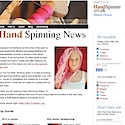I've seen wheels that have been finished with a dark stain, a coloured varnish or teak oil. All look good, but a good shine with clear wax does it for me.
Over time the wood darkens anyway. After even a few months, the wood is noticeably darker.
Some wax polish contains dyes which puts a little warmth and colour into your new wood. So how does it work on the natural wood of a new wheel?
To find out, this is brown Antiquax on a new Traveller wheel.

I like to use a brush to apply the wax (whether it's clear or brown). I think it might be more economical because the brush absorbs less than a cloth does. It's also easy to get into the crevices.
The first thing I notice is that it's much easier to see where you've been than with clear wax! It really does apply a beautiful colour to the wood.
It's scarily dark and lumpy when you apply it, but once buffed up the colour becomes very even. Some parts do seem to take the dye better than others, so there's a little bit of a difference, but I think the finished wheel is much more even than the variation in the colour of the natural parts straight out of the box.

The resulting colour is a beautiful bronzy-brown, not too dark. I've stood the finished wheel next to one polished with clear wax as a comparison. There's quite a difference which I don't think this photograph shows. I'm very pleased.















